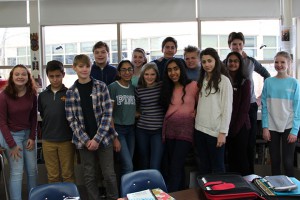December 8, 2016
My eighth grade global studies students and I began the second quarter of the 2016-17 academic year with a bold experiment to collaboratively plan and implement our unit on South Asia, including the topics (curriculum), class activities (pedagogy), and homework and projects (assessments). Typically, these decisions fall to teachers, administrators, or state legislators. Increasingly, education reformers are calling for this to change, arguing that student success is inextricably linked to student voices and experiences being present and honored in the classroom and curriculum.
Students in eighth grade global studies at MPA study four major geographical or political regions of the world for a quarter each: East Asia, South Asia, Sub-Saharan Africa, and North Africa and the Middle East. Although students do study some history as a part of each unit, much of the focus of the course is meant to be on the current political, economic, and social situations within each region, as well as how the region is increasingly interconnected with the rest of the world. Quarter two’s study of South Asia has traditionally included a look at the evolution of modern India, Pakistan, and Afghanistan. With my background in modern European history, I often feel safer, when faced with the unfamiliar terrain of South Asia, to rely on the familiar formulas of my discipline. In the past, this might have included an emphasis on the role of the British in the region as we explore colonization. Even as I encourage students to recognize a Western bias, I can sometimes fail to correct for such a biased approach in my own planning. I know that I am, in some cases, no more of a content expert when it comes to South Asia than many of my students. Even if I could break much of my ideation around teachers as “the sage on the stage,” I couldn’t quite yet see how I might have students co-plan our lessons, let alone a larger piece of the course.
“I was pleasantly surprised when every student was willing and excited to embark on the project.” – Mr. Dalbo
I began the 2016-17 school year with every intention of teaching the class largely the way I had taught it last year and the year before that. One assignment from our first quarter unit on East Asia had students question the prevailing historical narrative around Chinese-European colonial encounters in a popular world history textbook as being too Eurocentric or misrepresenting certain groups, such as minorities and women. As the students and I worked through this project of analyzing and rewriting sections of the textbook, understanding how historical narratives have the power to empower some peoples and silence others, I began to think about the narrative I construct within my own classroom and curriculum. I became more and more determined to rethink my next unit on South Asia. The class of 2021, this year’s eighth graders, has a relatively high percentage of students of South Asian descent: 16 percent currently, but as high as 23 percent last year. As I wrestled with how to reimagine the unit, I became determined to incorporate more student voices into the process. I introduced the idea to all eighth graders toward the end of the first quarter. Thinking only a handful would want to participate in some focus group-like conversations, I was pleasantly surprised when every student was willing and excited to embark on the project.
We spent three class periods talking about scope and sequence, formative versus summative assessment, and brainstorming about larger unit goals and smaller agendas. Students pushed me out of my own comfort zone to incorporate more lessons on religion and mythology, which we are now exploring and learning about together. Students each wrote their ideal assignment for the project. Although some chose to focus on a more-traditional nightly homework assignment, many created larger projects hitting on topics like the treatment of women in India, the threat to Bangladeshis as sea levels rise, and the creation and codification of Indian stereotypes through Bollywood films. In addition, we came up with a system for completing assignments, in which students are free to do any combination of student-teacher co-constructed assignments, so long as they reach a certain number of points. Thus, in any given week students have a choice of many different types of assignments, ranging from shorter nightly assignments to larger self-directed projects. This gives students the flexibility to choose work that matches their interest in a topic, learning styles, and schedule. I’ve overheard some students say that they are excited to do less reading and more writing, while others have expressed just the opposite.
In many ways, it is still a leap for me as a teacher to give more control to the students. However, I could clearly see their engagement and enthusiasm with the process and the curriculum as we embarked on the unit. Most amazing for me though, not a single student has leveled a single complaint about a homework assignment. Students seem genuinely excited about the assignments they had a hand in creating. Honestly, I find myself excited to dig into new material. Although we are only partially through our unit, the results are clear: excitement leads to engagement and, ultimately, deep learning.
